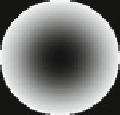Biomedical Engineering Reference
In-Depth Information
fabrication of sticky patches similar in size and shape with the DNA origami by
using electron-beam lithography followed by dry oxidative etching, sites on which
DNA origami bind with 70-95% probability of having an angular dispersion of
˙
20
ı
on SiO
2
and of
˙
10
ı
on diamond-like carbon.
DNA origami has also been used to arrange two types of single-walled CNTs in
a two-dimensional pattern (
Maune et al. 2010
). In this case, the different types of
CNTs functionalized with DNA linker molecules bind to specific hooks in ssDNA
that can be placed along DNA origami with a resolution of 6 nm. About half of
the templates had a single CNT attached and remained intact, as intended. CNTs
arranged in cross junctions using this method show stable field-effect transistor
behavior. The functionalized CNTs showed a preference in aligning parallel to the
complementary hook array.
Not only synthetic but natural biological architectures can be used as scaffolds.
For example, the chilo iridescent virus can act as template for the growth of a gold
shell (
Radloff et al. 2005
). In fact, viruses are optimal templates since they can
be grown as biotemplates in sizeable quantities and have a specified composition,
consisting of a capsid (proteinaceous shell) that encloses the genomic material, and
adaptable site-selective surface chemistry. Viruses come also in a large variety of
absolutely monodisperse morphologies, with both internal and external surfaces
amenable to functionalization with organic or inorganic molecules. The resulting
metallodielectric nanostructures support plasmonic resonances, which can be tuned
by varying the ratio between the radii of the dielectric core and metallic shell.
Nanoparticle plasmon resonances are quantized electron oscillations limited to
nanoscale volumes around the boundary of the nanoparticle, which enhance the
intensity of an electromagnetic radiation with the same frequency. The core can
become hollow and thus available for filling with different dielectrics after removal
of the genetic material. In particular, the chilo iridescent virus has a diameter of
140 nm and contains a dsDNA-protein core surrounded by a lipid bilayer, which
is sandwiched between outer and inner capsid shells, with 35-nm-long protruding
fibrils on the outer surface. The virus is first seeded with gold nanoparticles in
a concentrated NaCl electrolyte solution, which decreases the repulsive forces
between nanoparticles and favors fibril collapse on the virus capsid, except for
large NaCl concentrations, for which the gold nanoparticles aggregate on the virus
surface. The seeded viruses are then introduced in a gold ion solution, and Au shells
of different thickness form depending on the interaction time/concentration of gold
solution. For example, a 22-nm-thick shell exhibits a strong plasmon dipole mode at
about 800 nm and a quadrupole resonance at about 550 nm. The resulting gold shells
are rough, as suggested also by Fig.
5.12
, the surface irregularities broadening the
Fig. 5.12
Gold nanoparticles
on the spherical capsid of a
virus

























Search WWH ::

Custom Search